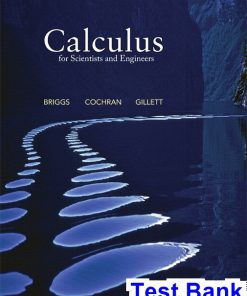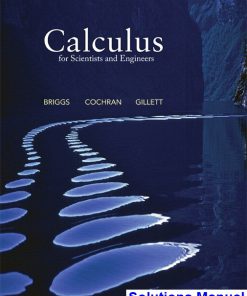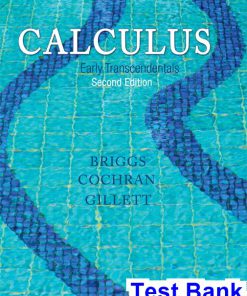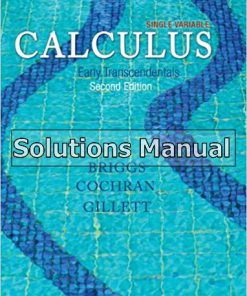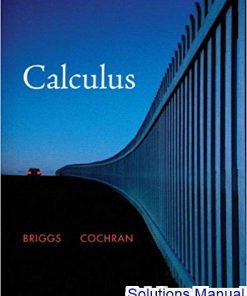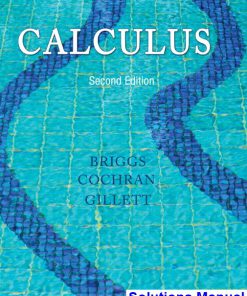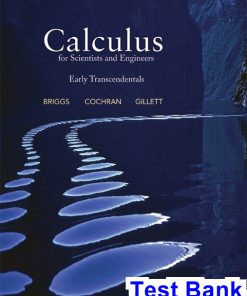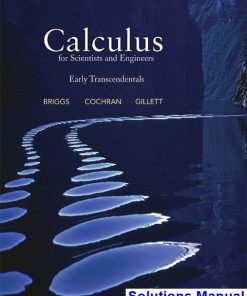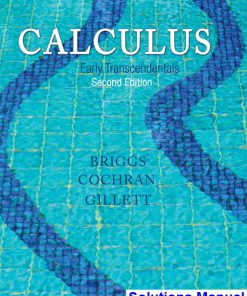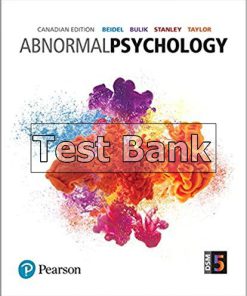Calculus 2nd Edition Briggs Test Bank
$50.00 Original price was: $50.00.$26.50Current price is: $26.50.
Calculus 2nd Edition Briggs Test Bank.
This is completed downloadable of Calculus 2nd Edition Briggs Test Bank

Product Details:
- ISBN-10 : 0321954890
- ISBN-13 : 978-0321954893
- Author: William Briggs, Lyle Cochran, Bernard Gillett
This much anticipated second edition of the most successful new calculus text published in the last two decades retains the best of the first edition while introducing important advances and refinements. Authors Briggs, Cochran, and Gillett build from a foundation of meticulously crafted exercise sets, then draw students into the narrative through writing that reflects the voice of the instructor, examples that are stepped out and thoughtfully annotated, and figures that are designed to teach rather than simply supplement the narrative. The authors appeal to students’ geometric intuition to introduce fundamental concepts, laying a foundation for the development that follows.
Table of Content:
1. Functions
1.1 Review of functions
1.2 Representing functions
1.3 Inverse, exponential, and logarithmic functions
1.4 Trigonometric functions and their inverses
2. Limits
2.1 The idea of limits
2.2 Definitions of limits
2.3 Techniques for computing limits
2.4 Infinite limits
2.5 Limits at infinity
2.6 Continuity
2.7 Precise definitions of limits
3. Derivatives
3.1 Introducing the derivative
3.2 Working with derivatives
3.3 Rules of differentiation
3.4 The product and quotient rules
3.5 Derivatives of trigonometric functions
3.6 Derivatives as rates of change
3.7 The Chain Rule
3.8 Implicit differentiation
3.9 Derivatives of logarithmic and exponential functions
3.10 Derivatives of inverse trigonometric functions
3.11 Related rates
4. Applications of the Derivative
4.1 Maxima and minima
4.2 What derivatives tell us
4.3 Graphing functions
4.4 Optimization problems
4.5 Linear approximation and differentials
4.6 Mean Value Theorem
4.7 L’Hôpital’s Rule
4.8 Newton’s Method
4.9 Antiderivatives
5. Integration
5.1 Approximating areas under curves
5.2 Definite integrals
5.3 Fundamental Theorem of Calculus
5.4 Working with integrals
5.5 Substitution rule
6. Applications of Integration
6.1 Velocity and net change
6.2 Regions between curves
6.3 Volume by slicing
6.4 Volume by shells
6.5 Length of curves
6.6 Surface area
6.7 Physical applications
6.8 Logarithmic and exponential functions revisited
6.9 Exponential models
6.10 Hyperbolic functions
7. Integration Techniques
7.1 Basic approaches
7.2 Integration by parts
7.3 Trigonometric integrals
7.4 Trigonometric substitutions
7.5 Partial fractions
7.6 Other integration strategies
7.7 Numerical integration
7.8 Improper integrals
7.9 Introduction to differential equations
8. Sequences and Infinite Series
8.1 An overview
8.2 Sequences
8.3 Infinite series
8.4 The Divergence and Integral Tests
8.5 The Ratio, Root, and Comparison Tests
8.6 Alternating series
9. Power Series
9.1 Approximating functions with polynomials
9.2 Properties of Power series
9.3 Taylor series
9.4 Working with Taylor series
10. Parametric and Polar Curves
10.1 Parametric equations
10.2 Polar coordinates
10.3 Calculus in polar coordinates
10.4 Conic sections
11. Vectors and Vector-Valued Functions
11.1 Vectors in the plane
11.2 Vectors in three dimensions
11.3 Dot products
11.4 Cross products
11.5 Lines and curves in space
11.6 Calculus of vector-valued functions
11.7 Motion in space
11.8 Length of curves
11.9 Curvature and normal vectors
12. Functions of Several Variables
12.1 Planes and surfaces
12.2 Graphs and level curves
12.3 Limits and continuity
12.4 Partial derivatives
12.5 The Chain Rule
12.6 Directional derivatives and the gradient
12.7 Tangent planes and linear approximation
12.8 Maximum/minimum problems
12.9 Lagrange multipliers
13. Multiple Integration
13.1 Double integrals over rectangular regions
13.2 Double integrals over general regions
13.3 Double integrals in polar coordinates
13.4 Triple integrals
13.5 Triple integrals in cylindrical and spherical coordinates
13.6 Integrals for mass calculations
13.7 Change of variables in multiple integrals
14. Vector Calculus
14.1 Vector fields
14.2 Line integrals
14.3 Conservative vector fields
14.4 Green’s theorem
14.5 Divergence and curl
14.6 Surface integrals
14.6 Stokes’ theorem
14.8 Divergence theorem
Appendix A. Algebra Review
Appendix B. Proofs of Selected Theorems
D1. Differential Equations (online)
D1.1 Basic Ideas
D1.2 Direction Fields and Euler’s Method
D1.3 Separable Differential Equations
D1.4 Special First-Order Differential Equations
D1.5 Modeling with Differential Equations
D2. Second-Order Differential Equations (online)
D2.1 Basic Ideas
D2.2 Linear Homogeneous Equations
D2.3 Linear Nonhomogeneous Equations
D2.4 Applications
D2.5 Complex Forcing Functions
People Also Search:
calculus briggs
calculus 2nd edition briggs
calculus 2nd edition
calculus 2nd edition testbank download pdf
calculus 2nd edition download scribd
Instant download after Payment is complete
You may also like…
Calculus and Mathematics
Calculus for Scientists and Engineers 1st Edition Briggs Test Bank
Calculus and Mathematics
Calculus for Scientists and Engineers 1st Edition Briggs Solutions Manual
Calculus and Mathematics
Mathematics
Calculus and Mathematics
Calculus and Mathematics
Calculus for Scientists and Engineers Early Transcendentals 1st Edition Briggs Test Bank
Calculus and Mathematics
Calculus for Scientists and Engineers Early Transcendentals 1st Edition Briggs Solutions Manual
Calculus and Mathematics
Calculus Early Transcendentals 2nd Edition Briggs Solutions Manual




